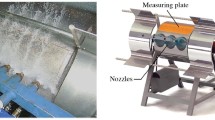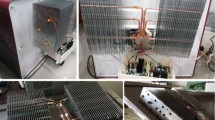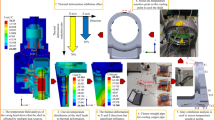Abstract
The thermal error suppression rate depends on the cooling effect of the water cooling system, and the cooling water flow rate is a direct factor affecting the cooling effect. To better reduce the thermal error, a numerical model of cooling water is established to solve for the optimal cooling water flow rate. Firstly, a numerical model of thermal deformation of the pendulum angle milling head is established based on thermoelasticity theory to determine the main heat sources leading to thermal deformation. Then, a numerical analysis model of the cooling water flow rate is established to investigate the cooling water flow rate that has the best effect on the suppression of thermal errors. Finally, five flow rates are used for cooling experiments to verify the accuracy of the numerical model. The results show that the temperature of each measurement point increases with the flow rate from a significant decrease to the basic constant trend of gradual saturation. The reduction rate of thermal error at v=54 cm/s is as high as 73.4%, providing a theoretical basis for enterprises to optimize water cooling system parameters.













Similar content being viewed by others
Data availability
Not applicable.
References
Jywe W, Hsu TH, Liu CH (2012) Non-bar, an optical calibration system for five-axis CNC machine tools. Int J Mach Tools Manuf 59:16–23
Sun YH, Xiao W, Hu RK, Huang MF (2014) Thermal characteristics analysis of mill head of five-axis CNC mill machine based on finite element method. Appl Mech Mater 446–447:509–512
Attia MH, Fraser SA (1999) Generalized modelling methodology for optimized real-time compensation of thermal deformation of machine tools and CMM structures. Int J Mach Tools Manuf 39:1001–1016
Dai Y, Yin XM, Wei WQ, Wang G, Zhan SQ (2020) Thermal error modeling of high-speed motorized spindle based on ANFIS. Chin J Sci Instrum 41:50–58
Fu GQ, Zhou LF, Lei GQ, Lu CJ, Deng XL, Xie LF (2022) A universal ensemble temperature-sensitive point combination model for spindle thermal error modeling. Int J Adv Manuf Technol 5:119
Zhang HF, Yakefu A, Aihaiti Y, Chen Y, He LQ (2023) An improved fourier transform method for measuring thermal boundary layer temperature field using fringe extrapolation. Int J Thermal Sci 189:108248
Zhao WQ, Liu HD, Shi H (2021) Detection and modeling for thermal error of machine tools. Sci Technol Eng 21:6546–6555
Yang H, Fang H, Liu LX, Zhang DJ, Yin GF, Xu DW (2011) Method of key thermal stiffness identification on a machine tool based on the thermal errors neural network prediction model, Journal of. Mech Eng 47:117–124
Umezu K, Ohashi K, Tsukamoto S (2013) Study on the Restraint method of thermal deformation in the machine tools. Adv Mater Res 797:603–608
Dai Y, Li Y, Li ZL, Wen WJ, Zhan SQ (2022) Temperature measurement point optimization and experimental research for bi-rotary milling head of five-axis CNC machine tool. Int J Adv Manuf Technol 121:309–322
Pan SW, Cao YJ, Fu JZ (2008) Research on the errors measurement for CNC machine tools. Machine Tool & Hydraulics 05(2008):335–337+331
Zhang ZX, Li FX (2019) Thermal error modeling and prediction method analysis of CNC machine tools. Mach Tool Hydraul 47:59–63
Nada Sameh A, El-Zoheiry RM, ElsharnobyOsman MOS (2022) Osman, Enhancing the thermal performance of different flow configuration minichannel heat sink using Al2O3 and CuO-water nanofluids for electronic cooling: An experimental assessment. Int J Thermal Sci 181:107767
Zhang LX, Li CQ, Li JP, Wu YH (2017) Influence analysis of cooling water parameters on high-speed spindle temperature field, Mechanical Science and Technology for. Aerospace Eng 36:1414–1420
Chen WH, He QC, He Q, Liu HZ, Ye J, Niu QP (2010) Simulation and experimental analysis for high-speed spindle with water-cooling system. China Mech Eng 21(2010):550–555
Li CP, Chai F, Cheng SK (2012) Research on the effects of cooling water velocity on temperature rise of the water-cooled motor in electric vehicles. Electr Mach Control 16:8
Lei CL, Rui ZY, Chen T, Zhou YC (2014) Research on the cooling system of high-speed motorized spindle. Appl Mech Mater 716:1707–1710
Borges SS, Cezario CA, Kunz TT (2008) Design of water cooled motorized motors using CFD and thermography techniques. Electrical Machines, 2008. ICEM 2008. 18th International Conference on. 1-6
Luo FQ, Ma C, Liu JL, Zhang L, Wang SL (2023) Theoretical and experimental study on rotating heat pipe towards thermal error control of motorized spindle. Int J Thermal Sci 185(2023)
Yang SY, Gao XH, Liu XX, Chen JK, Wang C (2011) Simulation on solid-fluid coupled heat transfer of water cooling system in high-speed electro-spindle. Mach Tool Hydraul 39:102–104+110
Yang T, Jing X, Li W, He Y, Yao JX (2021) Analysis of influence of different convex structures on cooling effect of rectangular water channel of motorized spindle. Appl Thermal Eng 198:117478
Lei MH, Jiang GD, Zhao L, Wang JS, Li BQ, Xia P, Yang JM, Mei XS (2020) Thermal error controlling for the spindle in a precision boring machine with external cooling across coated joints. Proc Inst Mech Eng Part C: J Mech Eng Sci 234:658–675
Wu L, Tan Q (2016) A study of cooling system in a grease-lubricated precision spindle. Adv Mech Eng 8(2016)
Yoshioka H, Matsumura S, Hashizume H, Shinno H (2004) Thermal deformation control of aerostatic spindle system using temperature controlled supply air. Trans Jpn Soc Mech Eng 70:3605–3610
Fu JZ, Yao XH, He Y, Shen HY (2010) Development of thermal error compensation technology for NC machine tool. Aeronaut Manuf Technol 4:64–66
Liu T (2016) Thermal error modeling and active control method of electric spindle unit, Tianjin University, p 52
Huang H, Li XD, Zhao CL (2022) Study on thermal error of motorized spindle based on thermoelastic theory and mean-value theorem of integral of temperature field. Chin J Sci Instrum 43:109–121
Funding
This work is supported by the National Natural Science Foundation of China (No. 52075134); the Opening Project of the Key Laboratory of Advanced Manufacturing and Intelligent Technology Ministry of Education, Harbin University of Science and Technology (No. KFKT202105); the Joint Guidance Project of Natural Science Foundation of Heilongjiang Province of China (No. LH2019E062); and the Special Funding for Postdoctoral Fellows in Heilongjiang Province of China (No. LBH-Q20097).
Author information
Authors and Affiliations
Contributions
Ye Dai: conceptualization, methodology, formal analysis; Yang Li: software, validation, writing—original draft; Shiqiang Zhan: experimental verification, data curation, visualization; Zhaolong Li: reviewing and editing; Xin Wang: material preparation, software; Weiwei Li: resources, supervision.
Corresponding author
Ethics declarations
Competing interests
The authors declare no competing interests.
Additional information
Publisher's Note
Springer Nature remains neutral with regard to jurisdictional claims in published maps and institutional affiliations.
Rights and permissions
Springer Nature or its licensor (e.g. a society or other partner) holds exclusive rights to this article under a publishing agreement with the author(s) or other rightsholder(s); author self-archiving of the accepted manuscript version of this article is solely governed by the terms of such publishing agreement and applicable law.
About this article
Cite this article
Dai, Y., Li, Y., Zhan, S. et al. Numerical model establishment and experimental study of milling head cooling water flow rate. Int J Adv Manuf Technol 132, 1613–1625 (2024). https://doi.org/10.1007/s00170-024-13308-1
Received:
Accepted:
Published:
Issue Date:
DOI: https://doi.org/10.1007/s00170-024-13308-1




